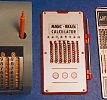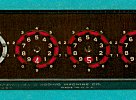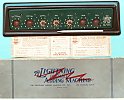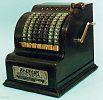These fairly simply devices were made for adding and subtracting. The dial and chain models shown had automatic tens carry. The slide adders, however, required help from the user to carry. The user had to notice that a carry was needed, and pull the stylus back in the other direction, and around a hook shape in order to advance the next slide one position. Thus, the slide devices were really adding aids, rather than true adding machines and were very simple in construction. All of these machines (especially the dial machine) could produce errors if the stylus wasn't held at the proper angle. The dial machine was cleared by the red lever to the left. The slide machines were cleared by pulling a small bar on the top.
The longer adder on the right provided a separate window below the adding window for subtraction. The other two machines were a bit trickier and provided complementary digits printed next to the additive digits.

|
Picture one dial and two flat stylus adders |
The picture below shows a Precise adding machine. It's the "industrial strength" version of the dial adder above featuring all metal construction. While under 5" wide, it weighs in at a hefty 4.5 lbs.

|
Picture of the Precise Adder |
Operation of the GEM adding machine shown below was similar to the dial adders above including automatic carries, but thanks to the chain drive, the size and shape was more like a slide device. The device came with a leather case and a metal tipped stylus and was cleared by turning the knob at the lower right.
The Gem was introduced in 1904 and the machine came in many models with 7, 8, or 9 columns, and with or without complementary digits for subtraction. There were also fractional models which added 8ths in the last column and a British currency model that added farthings, pence, shillings and pounds. Models could be special-ordered with bushings, barrels, feet, inches, hours, minutes, etc. and there were finish options including a Golden color (called a "Golden Gem".)
The machine pictured is a Model 207, Type "Standard" with a rippled black finish, seven columns and a price of $9.95. Its warranty card shows it to have been purchased in February of 1939.

|
Picture a Gem adding machine |
The picture below shows an Addometer made by Reliable Typewriter and Adding Machine Co. around 1920. This device was similar in operation to the original Pascal adding machine but at 11.5" x 2.4" x .7" and with a weight of 1.5 pounds, it was much more portable. It featured automatic tens carry in all places during addition and subtraction, but adding 1 to 999999 required a lot of effort since the user was rotating 7 digits at once. To add, the larger inner digits were used and the wheels were turned clockwise. To subtract, the smaller outer digits were used and the wheels were town counter-clockwise.
The Addometer was guaranteed for a year but if it was mailed back to the factory the owner needed to include $0.35 for return postage, insurance and handling. (It took $3.00 in postage alone to mail it to the museum in 1996.) In contrast to today's typical product disclaimer, the Addometer was guaranteed "to be perfect".

|
Picture an Addometer |

|
Picture an Addometer designed for inch/feet math |
This is similar to the one above, but notice that the last wheel is used to enter numbers from 1/8 to 7/8 and the next to last wheel is used to enter numbers from 1 to 11 (inches and fractions.)
The picture below shows a Lightning Adder which was similar to the Addometer above but somewhat less expensive in construction and lacking a clearing mechanism. This machine required the user to clear each dial by rotating it to zero. It was introduced in 1908.

|
Picture a Lightning Adder |
This was a transitional machine. It was similar to the dial adders in its shape but with an unusual mode of data entry. To enter each number to add, the user placed a finger in the depression for that digit and used the thumb of the same hand to raise the chrome lever for that position until it stopped at the finger. Each lever stayed in position allowing the user the check the number entered before adding it to the sum - a major limitation of the machines above. If the number was in error, the small crank on the right side of the machine would clear it. The large crank added it, and two cranks of the large crank in a row cleared the sum which was displayed in the windows on the top of the machine. This machine was very sturdily built and was introduced in 1913.

|
Picture an American Adding Machine |
Two adding machines designed for kids are displayed below. The Wolverine was very simple lacking even a clear feature. The Hasbro did have a clearing feature but to quote the manual:
"To clear your machine, make sure there are no nines or zeros showing in the answer windows. Pull "Total" bar toward you firmly and look at the answer windows. If there are nines and/or zeros visible, place index finger from right to left in top holes of the columns where the nines and zeros appear. Depress to any other number. Now place finger on "clear" bar and depress it as far as it will go. While "clear" bar is depressed, start from right to left and place index finger in top hole of each column and pull toward you to a natural stop (as far as it will go without forcing). All columns will not necessarily work down to same position or to finger stop. Pull "Total" bar toward you and you will see 0's in the 5 columns."
It also featured a total lever which simply covered the register when closed and revealed it - while ringing the total bell - when opened.

|
Picture of the Wolverine Adder |

|
Picture of the Hasbro Adder and box |
![]() Back to early models contents
Back to early models contents
![]() Go on to the printing models.
Go on to the printing models.
![]() Back to the adding machine page.
Back to the adding machine page.